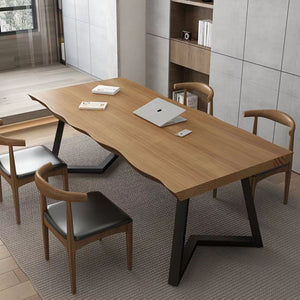In the world of interior design, live edge furniture has emerged not merely as a passing fad but as a powerful statement. It's a harmonious celebration of nature's raw beauty, the finesse of craftsmanship, and the allure of individuality. But how did this captivating design concept come into existence? And what has propelled it to its current soaring popularity? Join us as we embark on a journey through the rich history of live edge design, its remarkable evolution, and a glimpse into the exciting future that lies ahead.
The Origins of Live Edge Design
The roots of live edge furniture stretch back through the annals of time, spanning centuries. Early civilizations, such as the Native American and Japanese cultures, held a deep appreciation for the organic allure of raw wood. Instead of attempting to eliminate the so-called imperfections, they chose to spotlight them, recognizing a truth that often eludes us in modern times: nature is, without a doubt, the most brilliant designer.
Fast-forwarding to the mid-20th century, one name shines brightly in the history of live edge design: George Nakashima. A Japanese-American architect and woodworker, Nakashima revolutionized our perception of natural wood in furniture. He didn't see the raw edges, the knots, or the cracks as flaws; rather, he regarded them as the unique fingerprints of the tree's life journey. His guiding philosophy was simple yet profound: work in harmony with the wood, not against it.
Nakashima's painstakingly handcrafted tables and chairs quickly garnered acclaim for their authenticity and artistic flair. His influence is far-reaching, and his legacy continues to inspire designers and furniture makers across the globe to this day. His pieces were not just functional; they were works of art that told a story of the tree and the craftsman's respect for nature.
How Live Edge Furniture Has Evolved?
Over the years, live edge furniture has undergone a remarkable transformation, transitioning from a niche artisan's specialty to a mainstream design favorite. Here's a closer look at how it has evolved:
From Rustic to Refined
In its early days, live edge furniture boasted a rugged, unpolished aesthetic. It was a bold and unapologetic display of raw nature. However, as designers began to experiment, they refined the process. Through meticulous sanding, elegant finishing, and innovative combinations of materials like steel and resin, they transformed these pieces into high-end, eye-catching statement pieces. These refined live edge creations seamlessly blend the charm of nature with the sophistication of modern design, appealing to a wider range of tastes.
Technology Meets Tradition
The advent of advanced woodworking techniques, such as CNC routing and epoxy resin fills, has opened up new possibilities. These technologies allow artisans to achieve a level of precision that was once unimaginable. Now, they can preserve the natural beauty of live edges while ensuring the furniture's durability and stability. It's a perfect marriage of age-old craftsmanship and cutting-edge technology, enabling the creation of pieces that are both beautiful and long - lasting.
A Sustainable Choice
In an era of growing environmental awareness, with deforestation and ecological concerns at the forefront, reclaimed wood and responsibly sourced slabs have become increasingly popular. Many live edge tables today are crafted from salvaged wood, giving a second life to trees that might otherwise have been discarded. This not only reduces the environmental impact but also adds a unique character to each piece, as the wood carries with it the history of its previous life.
Beyond Dining Tables
What began as a design movement primarily focused on dining tables has now expanded far and wide. Live edge coffee tables, headboards, shelving units, and even countertops are all the rage. This expansion has allowed homeowners to incorporate the beauty of live edge design into various aspects of their living spaces, creating a cohesive and nature - inspired interior.
Why Live Edge Furniture is Popular Today?
In a world dominated by mass production, people are yearning for something unique. Live edge furniture answers that call perfectly. Here are the reasons why it continues to gain momentum:
No Two Pieces Are the Same
Each slab of wood has its own distinct grain, knots, and edges. This means that every live edge furniture piece is truly one-of-a-kind. When you own a live edge table or chair, you possess a unique item that cannot be replicated, adding a touch of exclusivity to your home.

Blends with Any Style
Whether your home decor leans towards modern minimalism, rustic charm, industrial edginess, or a cozy farmhouse aesthetic, live edge furniture seamlessly complements it. Its natural beauty serves as a neutral yet striking element that can enhance any design style, making it a versatile choice for homeowners.
Brings Nature Indoors
As urbanization continues to spread, people are increasingly seeking ways to reconnect with nature. Live edge furniture provides the perfect solution. It brings the warmth, texture, and organic beauty of the outdoors into the comfort of our homes, creating a sense of tranquility and connection to the natural world.
Heirloom Quality
Unlike mass-produced furniture that may quickly show signs of wear and tear, a well -crafted live edge table is built to last generations. It's not just a piece of furniture; it's a family heirloom that can be passed down through the years, carrying with it stories and memories.
Future Trends in Live Edge Furniture
What does the future hold for live edge design? Here are some trends we can expect to see:
More Epoxy Resin Infusions
We can anticipate even bolder color choices, mesmerizing ocean-like waves, and perhaps even embedded objects in tabletops. Epoxy resin infusions will allow for even more creative and unique designs, pushing the boundaries of what's possible with live edge furniture.

Mixed Materials
The combination of live edge slabs with metal, glass, and concrete will become more prevalent, creating innovative and industrial-inspired looks. These mixed-material designs will offer a fresh take on live edge furniture, appealing to those with a taste for the avant-garde.
Sustainable Practices
As environmental concerns grow, more designers will focus on sourcing wood locally, using reclaimed materials, and embracing eco-friendly finishes. Sustainability will be at the forefront of live edge design, ensuring that these beautiful pieces are also kind to the planet.
Customization at Scale
With the increasing demand for live edge furniture, even larger retailers may start offering semi-custom live edge pieces. This will make it more accessible for consumers to own a personalized live edge item that suits their specific needs and preferences.
Conclusion
Live edge furniture is much more than a passing trend; it's a design movement that has captured the hearts of many. It's a way of embracing the imperfections of nature and transforming them into something truly breathtaking. From its humble beginnings in ancient cultures to the modern-day innovations, live edge design has continuously evolved while staying true to its core values.
Whether you own a live edge dining table that serves as the centerpiece of your home, a cozy coffee table for lazy Sunday mornings, or a stylish shelving unit that showcases your favorite books and decor, you're not just decorating your space. You're bringing a piece of nature's beauty and history into your home. And that's something that will never go out of style.
So, the next time you run your hand along the edge of a live edge table, take a moment to pause. Feel the unique texture, and let your eyes trace the story written in its grain. Because what you're touching isn't just wood; it's a centuries-long narrative of nature, craftsmanship, and the enduring appeal of live edge design.

